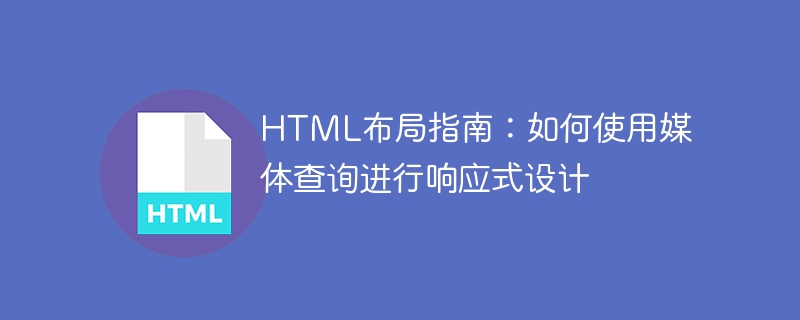Home >Web Front-end >HTML Tutorial >HTML Layout Guide: How to Use Media Queries for Responsive Design
HTML Layout Guide: How to Use Media Queries for Responsive Design
- WBOYWBOYWBOYWBOYWBOYWBOYWBOYWBOYWBOYWBOYWBOYWBOYWBOriginal
- 2023-10-21 10:58:421251browse

HTML Layout Guide: How to Use Media Queries for Responsive Design
With the proliferation of mobile devices and the emergence of multiple screen sizes, responsive design has become the norm for web pages important part of design. By using media queries to adjust and adapt to the screen sizes of different devices, you can ensure that your web pages present the best user experience on different screens.
Media queries allow us to provide different styles and layouts for different screen sizes based on different device conditions. Simply put, we can make conditional judgments based on screen width, height, resolution and other parameters, and provide corresponding CSS styles for each condition.
The following will introduce how to use media queries to implement responsive layout. In the example, we will try to create a responsive navigation bar.
First, introduce the CSS style sheet into the
tag of the HTML file:<link rel="stylesheet" href="style.css">
Then, define the style of the navigation bar in the CSS file, including background color, font size, etc.:
.navbar {
background-color: #333;
color: white;
font-size: 16px;
}
.navbar li {
display: inline-block;
padding: 10px;
}
.navbar a {
color: white;
text-decoration: none;
}Next, we need to use media queries to adjust the style of the navigation bar in different screen sizes. We can add the following code to the CSS file:
@media (max-width: 768px) {
.navbar {
background-color: blue;
font-size: 14px;
}
.navbar li {
display: block;
padding: 5px;
}
}The above code represents the style setting when the screen width is less than or equal to 768 pixels. In this case, the background color of the navigation bar will change to blue, the font size will be reduced to 14 pixels, and each option of the navigation bar will be displayed as a block-level element (display: block).
Media queries use conditional expressions to control style changes under specific screen sizes. The conditional expression (max-width: 768px) in the above example indicates that devices with a screen width less than or equal to 768 pixels are selected.
In this way, we can provide different styles for the navigation bar in different screen sizes as needed. This makes our navigation bar adaptable on both large and small screen devices. When users visit a web page on a different device, they will see the navigation bar style that best suits their device.
In actual use, we can add multiple media queries as needed and provide corresponding styles for each media query. In this way, under different screen sizes, we can adjust and optimize the layout and style of the web page for a better user experience.
To summarize, using media queries is one of the important techniques for implementing responsive layout. It allows us to provide different styles and layouts to accommodate different screen sizes based on device conditions. By using media queries appropriately, we can ensure that web pages present the best user experience on a variety of devices.
The above is a brief guide on how to use media queries to implement responsive layout. I hope it will be helpful to beginners. In practice, further learning and exploration can be carried out according to specific needs and situations.
Reference:
- [MDN Web Docs - Using media queries](https://developer.mozilla.org/en-US/docs/Web/CSS/Media_Queries/ Using_media_queries)
- [W3Schools - CSS3 Media Queries](https://www.w3schools.com/css/css3_mediaqueries.asp)
The above is the detailed content of HTML Layout Guide: How to Use Media Queries for Responsive Design. For more information, please follow other related articles on the PHP Chinese website!

